- Accueil
- Base de données
- 53
- RAF
- 11 June, 1940
11 June, 1940
Armstrong Whitworth Whitley MkV (N1362 - code KN-Q)
"La Boulardière" - Lignières-Orgères (53)
(contributors : John Ombler, Philippe Dufrasne, France Crashes 39-45)
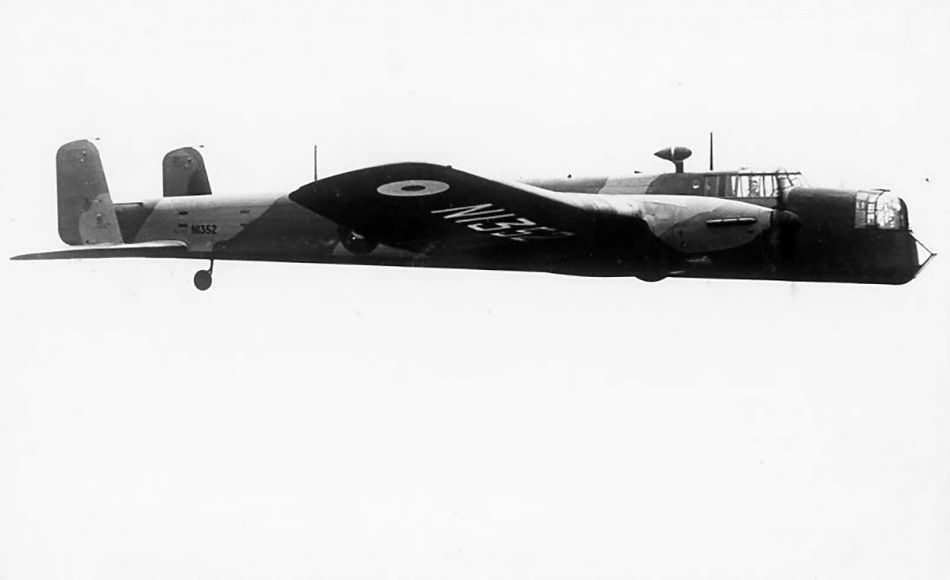
Armstrong Whitworth Whitley Mk V N1352 of No. 77 Sqn
San Diego Air and Space Museum Archives - Charles Daniel photo collection
Crew (No. 77 SQN, RAF)
all crew members buried in the communal cemetery in Lignières-Orgères
- Sergeant (pilot) Norman Martin SONGEST, 23 years old, killed.
Born March 1,1917.
Royal Air Force, service number 580330.
- Sergeant (pilot) Philip Henry James BUDDEN, 26 years old, killed.
Born December 4, 1913.
Son of Julian Evlyn and Mary Budden, husband of Ann Elizabeth Budden, from Birmingham.
Royal Air Force Volunteer Reserve, service number 742113.
- Sergeant (Wireless operator/gunner) Ronald Charles ASTBURY, 20 years old, killed.
Son of Charles George and Ethel Caroline Astbury from Cosham, Hampshire.
Royal Air Force, service number 630781.
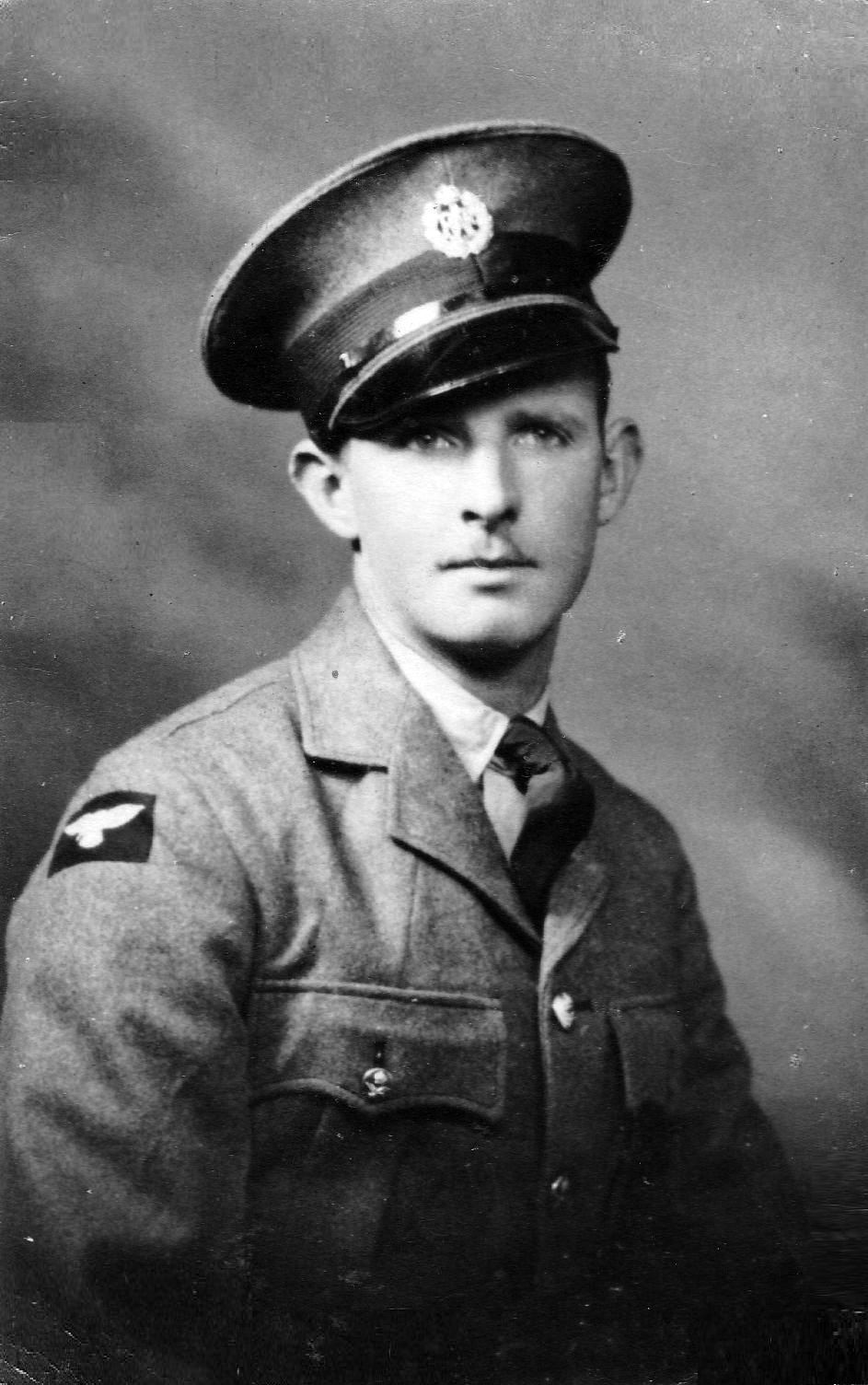
Ronald Charles ASTBURY
Photo © Johan Pauwels
- Sergeant (Wireless operator/gunner) Edward OMBLER, 18 years old, killed.
Son of John Denman and Isabel May Ombler, from Hull.
Royal Air Force, service number 633791.
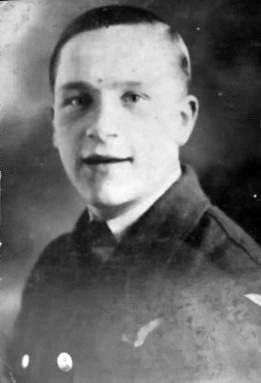
Edward Ombler
Photo collection John Ombler
- Sergeant (Observer) Alexander FINDLAY, 28 years old, killed.
Son of Alexander and Maggie Findlay, from Edinburgh.
Royal Air Force Volunteer Reserve, service number 749540.
THE STORY
Takeoff at 2:00 PM from RAF Driffield, Yorkshire. The mission was to attack the Fiat works in Turin (Italy), via Jersey to refuel. The aircrafts were to fly from Driffield to Poole and then Jersey. All aircrafts arrived in Jersey and took off again from 8:00 pm at 10-minute intervals until 9:45 pm. They were to cross the French coast at Saint-Cast [de Guildo]. Due to icing problems at high altitude (above 10,000 feet), most of the crews experienced engine problems and the mission was not a success. The aircrafts also encountered electrical storms and intense flak on the target. Unfortunately, Sergeant SONGEST's crew was reported missing.
Various testimonials reveal that this night, an aircraft in difficulty, arriving from Ciral (in neighboring Orne department), crashed at La Boulardière at 9:30 pm, not far from Orgères-la-Roche. An archival document (see appendices) specifies that the aircraft likely crashed accidentally, as there were no German anti-aircraft guns or fighters nearby. The following day, smoking wreckage and the bodies of the crew members still littered the site. The mayor of Orgères at the time, Mr. Norman, informed by French officers who went to the scene and identified unexploded bombs, asked the population not to approach. These wreckage remained like this for several days due to the chaos linked to the approach of the Germans (it was June 11, 1940). The population was experiencing dramatic moments, many having already left. Some time later, German soldiers came to evacuate the village to detonate the intact bombs.
An archive document (see appendices) informs us that initially, the bodies and remains of the 5 airmen were separated. The bodies of Songest and Budden were taken by the International Red Cross to a hospital in Le Mans, then buried in the Grand-Lucé communal cemetery. The bodies were identified by Songest's signet ring, and Budden's lighter. The other three bodies were placed in a large coffin and buried in the communal cemetery of Lignières-la-Doucelle.
Note :
(Source of information: Lignières-Orgères town hall website)
- On November 24, 1918, following a letter from the Sub-Prefect of Mayenne requesting that the town's name be changed or supplemented to avoid confusion in postal services and the transport of goods, the Town Council decided to add a suffix to the town's name, which would then be called "Orgères-La Roche".
- On January 1, 1972, the towns of Lignières-La Doucelle and Orgères-La Roche merged. The new town took the name Lignières-Orgères (associated towns).
- On June 28, 1987, a referendum was held in Orgères, which voted in favor of the complete merger. The new town then adopted the name "Lignières-Orgères" permanently.
EDWARD OMBLER

A newspaper article, probably published in 1940, informs us that Edward Ombler
joined the RAF at the age of 17 while working for the Oxide company in Stoneferry,
in the suburb of Hull. He attended the Brunswick Avenue School in Hull.
John Ombler, Edward Ombler's nephew, has shared with us for our great pleasure some photos of Edward Ombler and his mother.
We think it is important to pay tribute Edward Ombler by publishing these photos. Edward Ombler's family home was on Newbridge Road in Hull. He had one sister and four brothers. Two of his brothers, Alan and John, also served in the British Army and survived the war. Alan was a Dunkirk survivor. Peter Ombler (John's father) was still a child (born September 30, 1931, and died in 2023). After the plane crash, few details were known in England, and Edward was considered missing, presumed dead. After the war, the government made considerable efforts to find and identify the missing. Edward was one of them. It was only much later that his parents finally discovered the details.
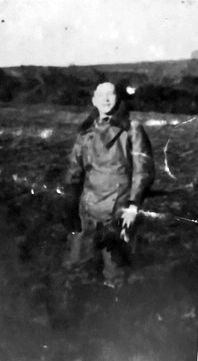
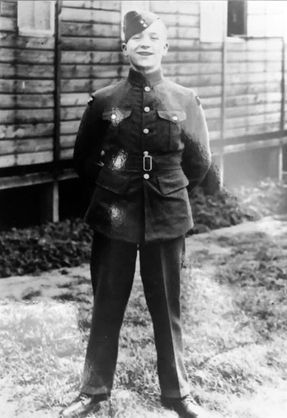
Edward Ombler, a young man of barely 18, visibly happy to be an airman
Photo collection John Ombler
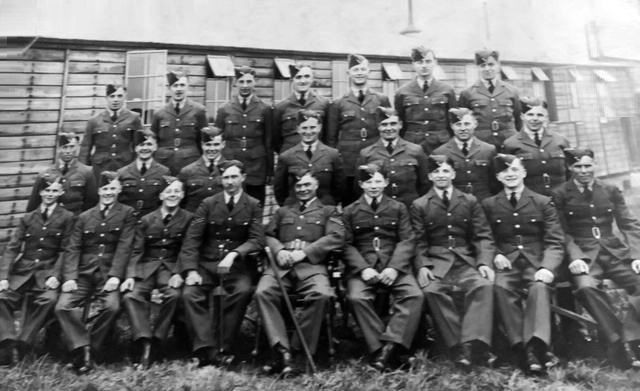
Edward Ombler probably with his comrades from No. 77 Squadron
Photo collection John Ombler
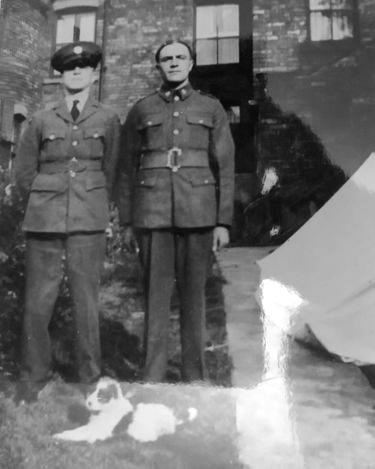
Edward Omber (left) with his brother Alan
Photo collection John Omber
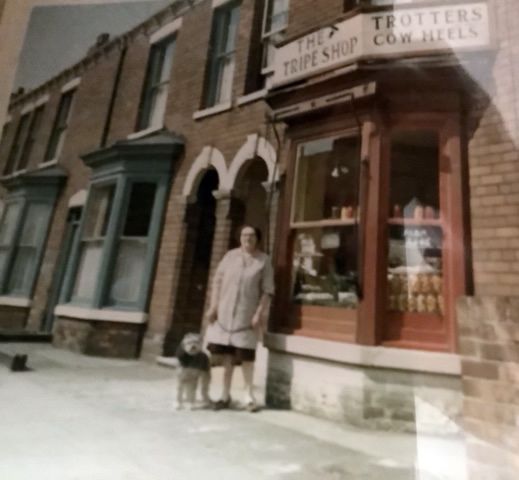
Mrs Ombler, Edward's mother, outside her shop on Newbridge Road, Hull.
Photo collection John Ombler

Mrs Ombler in her shop
Photo collection John Ombler
TESTIMONIALS
♦ Letter from Mr Henri Lemaître, from Lignières-Orgères, dated November 21, 1980, to Mr Peter Ombler, bother of Sergeant Edward Ombler killed on June 11, 1940.
(document John Ombler)
" Mister and Mrs P. Ombler,
I, the son of Mr. and Mrs. Lemaître, responds to your letter.
Yes, we received your letter in September, along with the photo, and we thank you very much. I apologize to my parents who, due to their age, are no longer able to write you.
You are asking for information about what happened during that tragic night of June 11, 1940. I can provide some information because I was there. I was only 5 years old, yet I remember. That night, my mother rushed me out of the house when the aircraft hit the ground. The explosion was massive ; it fell 250 meters from the village. The next day, on the site of the disaster, I saw again the still-smoking wreckage of a broken-up aircraft, scattered within a radius of 200 meters or more. I also saw dead crew members. The bodies remained there for several days, the dramatic events that the population was experiencing explain why no one thought of burying the victims ; the Germans were not yet in Orgères, but the roar of the cannon indicated that they were approaching and many people had fled.
I can't tell you how many days they stayed ; I don't remember. However, I do remember that some time later, German soldiers came to the village to make us leave because they wanted to detonate several bombs that had remained intact. I enclose with this letter a key found in the wreckage of the aircrat forgotten in a drawer.
If you return to France, I will make it my duty to show you the spot where it fell, and my two children, who are studying English, can act as interpreters.
Before concluding, I would like to wish you and your mother a Merry Christmas and also my best wishes for happiness and health in 1981.
Please accept, Mr. and Mrs. Ombler, my most sincere regards.
Mr Henri Lemaître. "
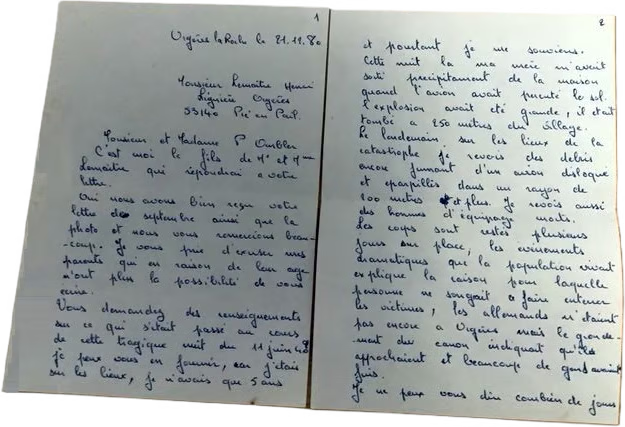
collection John Ombler
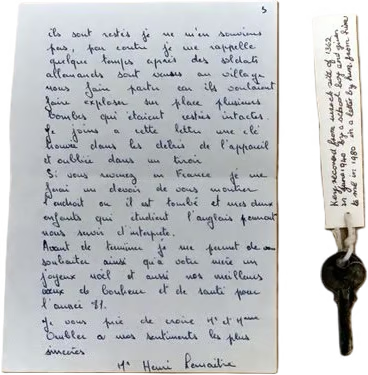
collection John Ombler
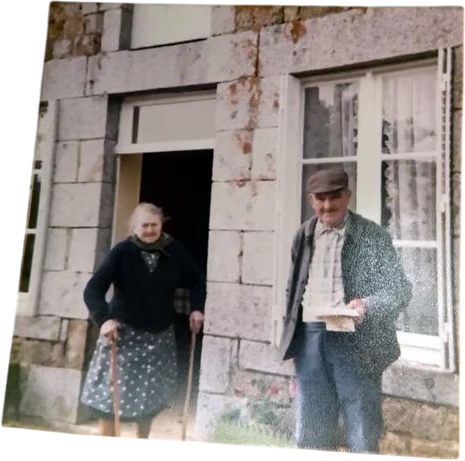
Mr and Mrs Lemaître, parents of Henri Lemaître, author of the letter sent to P. Ombler
collection John Ombler
♦ "War memories in Lignières".
(extract from a document by André Robert - Source website France Crashes 39-45)
" Tuesday, June 11 [1940], night has fallen. Suddenly, we heard the sound of an aircraft engine. We left the house and saw an aircraft that seemed to face problems : it was coming approximately from the direction of Ciral ; lights came out and we could hear crackling sounds. It seemed to lose altitude then disappeared, a big explosion occurred and then no more noise. Was the aircraft German ? Did it drop time bombs (there was a lot of talk about it). It was also a time when people were not very familiar with aircrafts... we would find out later ! Night passed. On Wednesday morning, we learned that an aircraft had crashed at La Boulardière, that it was English and that little remained of it. It was lying in the middle of the road, just before the turnoff to this village ; the crew members were charred. There is a strange smell coming from this largely burnt wreck, a parachute in a bad state is hanging from a furrow located in the hedge near the wreck, and a wing was thrown off by the explosion near La Bousse. This aircraft was guarded for a few days by French soldiers, then abandoned as the French retreated. The Germans occupying Lignières ensured the burial of the remains of the five airmen, burying them in the cemetery where they are now.
The wooden crosses bore the following inscription:
« Hier Ruken 5 Englisch flieger »
« Here lie 5 English airmen » ".
IN MEMORIAM
The municipality of Lignières-Orgères (a merger of the former municipalities of Lignières-la-Doucelle and Orgères-la-Roche) pays tribute to the five airmen who fell in June 1940 at the war memorial and on an information panel near the church. The five airmen are buried in the Lignières-Orgères cemetery (formerly the Lignières-la-Doucelle cemetery).
♦ The pannels near the church :

The war memorial of Lignières-Orgères todayi
Photo ABSA 39-45 - Benoit Paquet
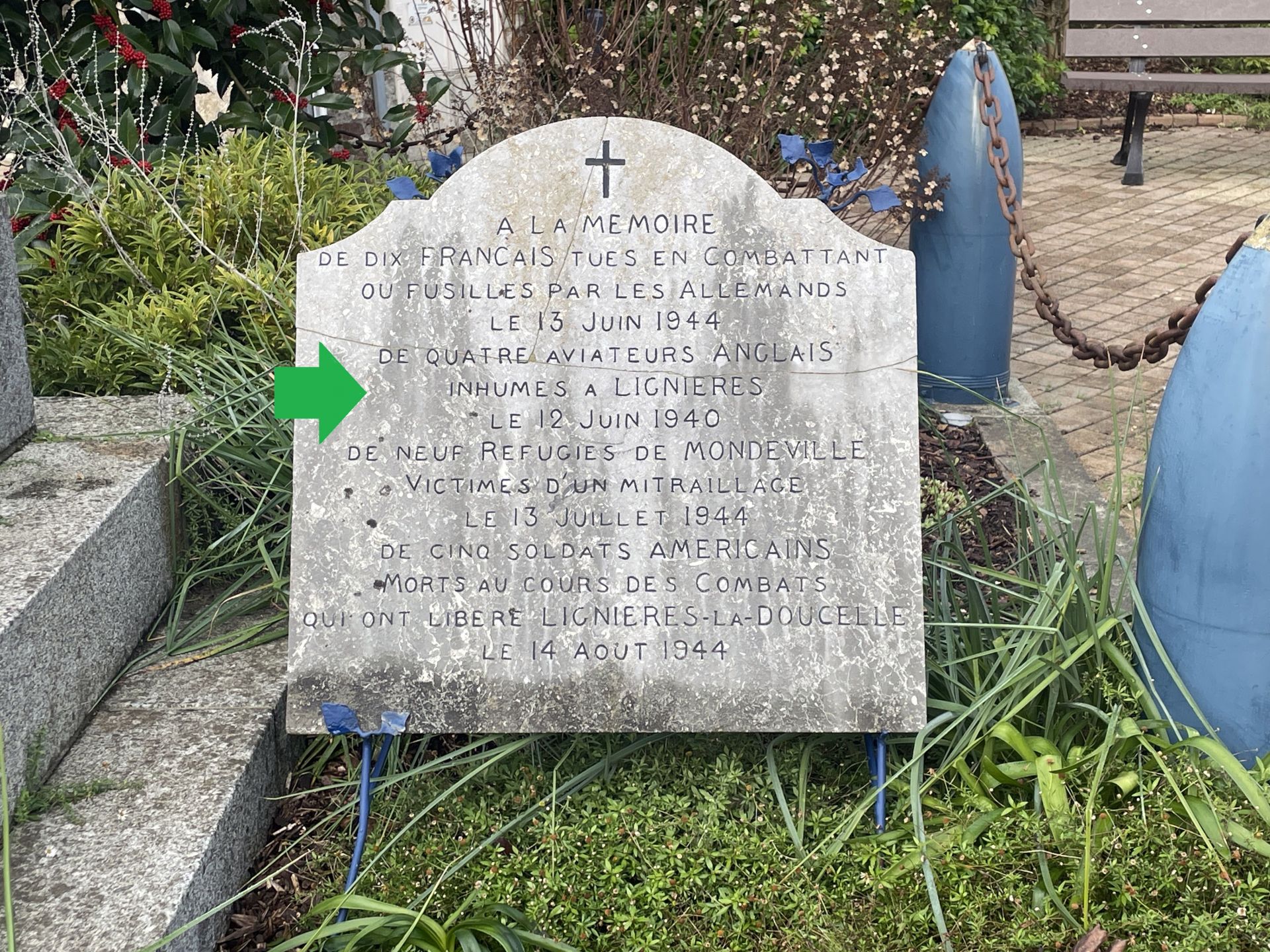
To the right of the monument, a plaque commemorates those who died in the Second World War, including 4 airmen [actually there were 5] who fell on June 11, 1940.
It states that they were buried on June 12, 1940, although several accounts indicate that it was several days after the crash.
Photo ABSA 39-45 - Benoit Paquet

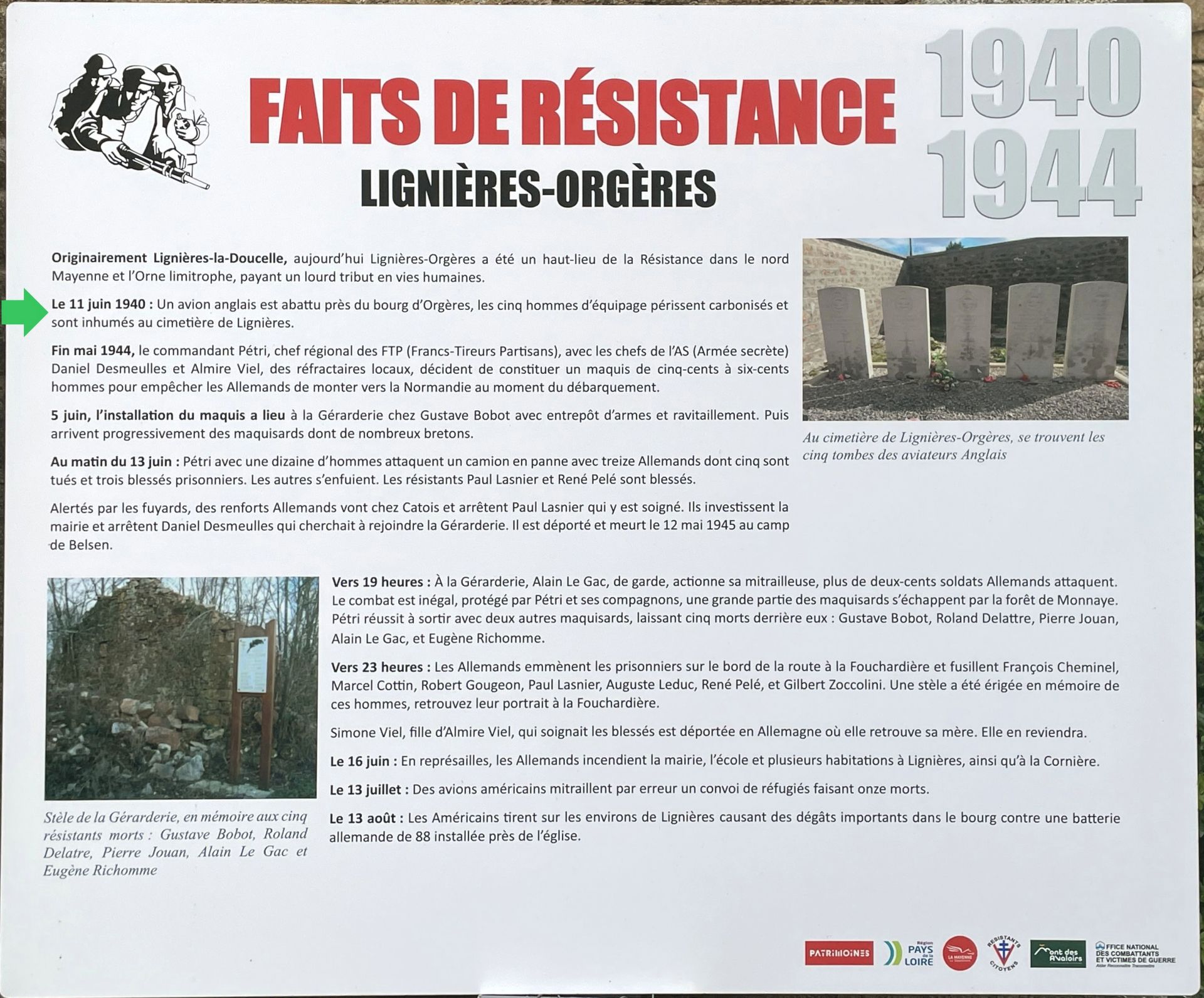
Near the war memorial, an information panel summarizes the events of the war and resistance in Lignières-Orgères,
notably the sacrifice of the 5 British airmen.
Photo ABSA 39-45 - Benoit Paquet
♦ Graves of the five airmen in the Lignières-Orgères cemetery
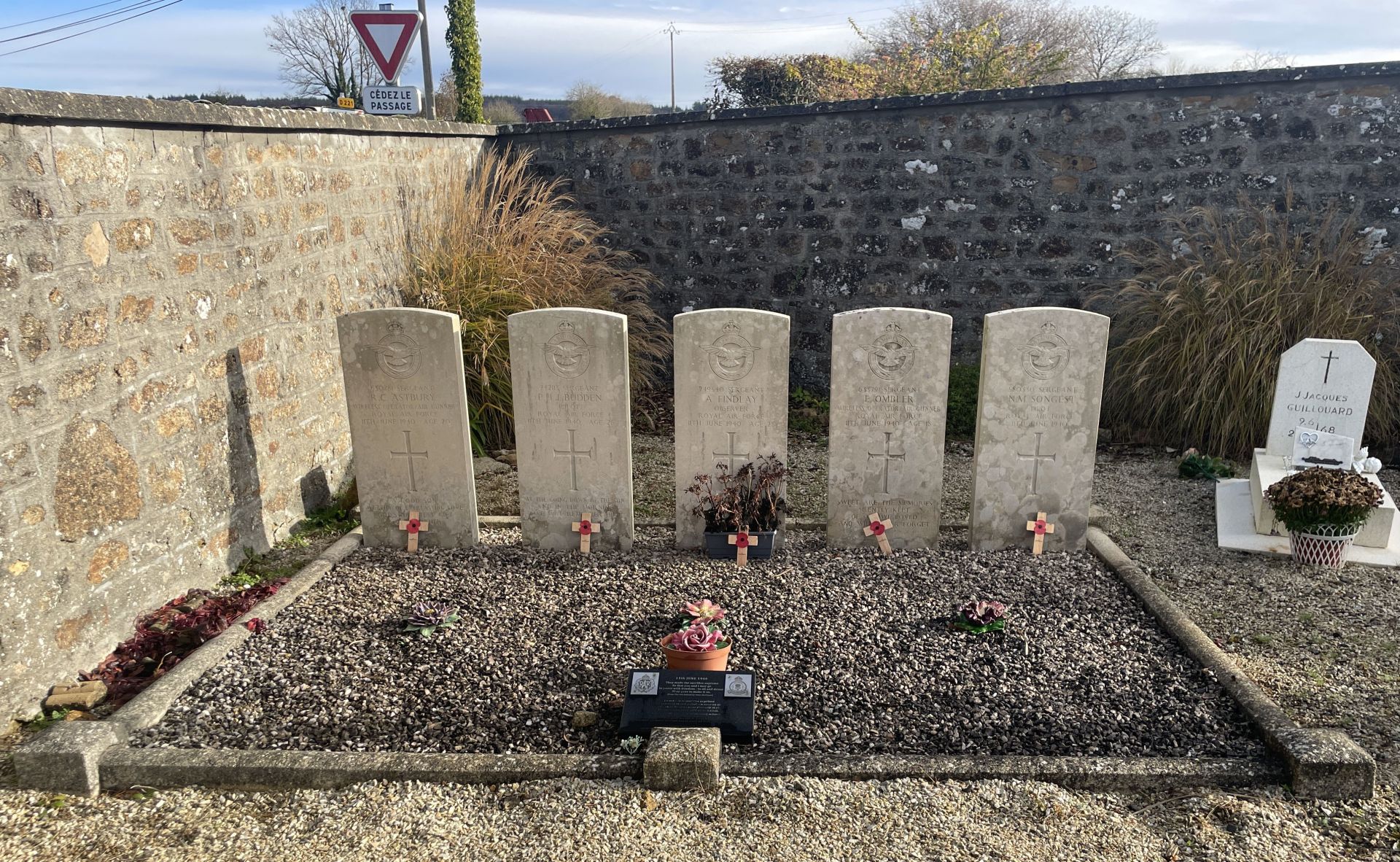
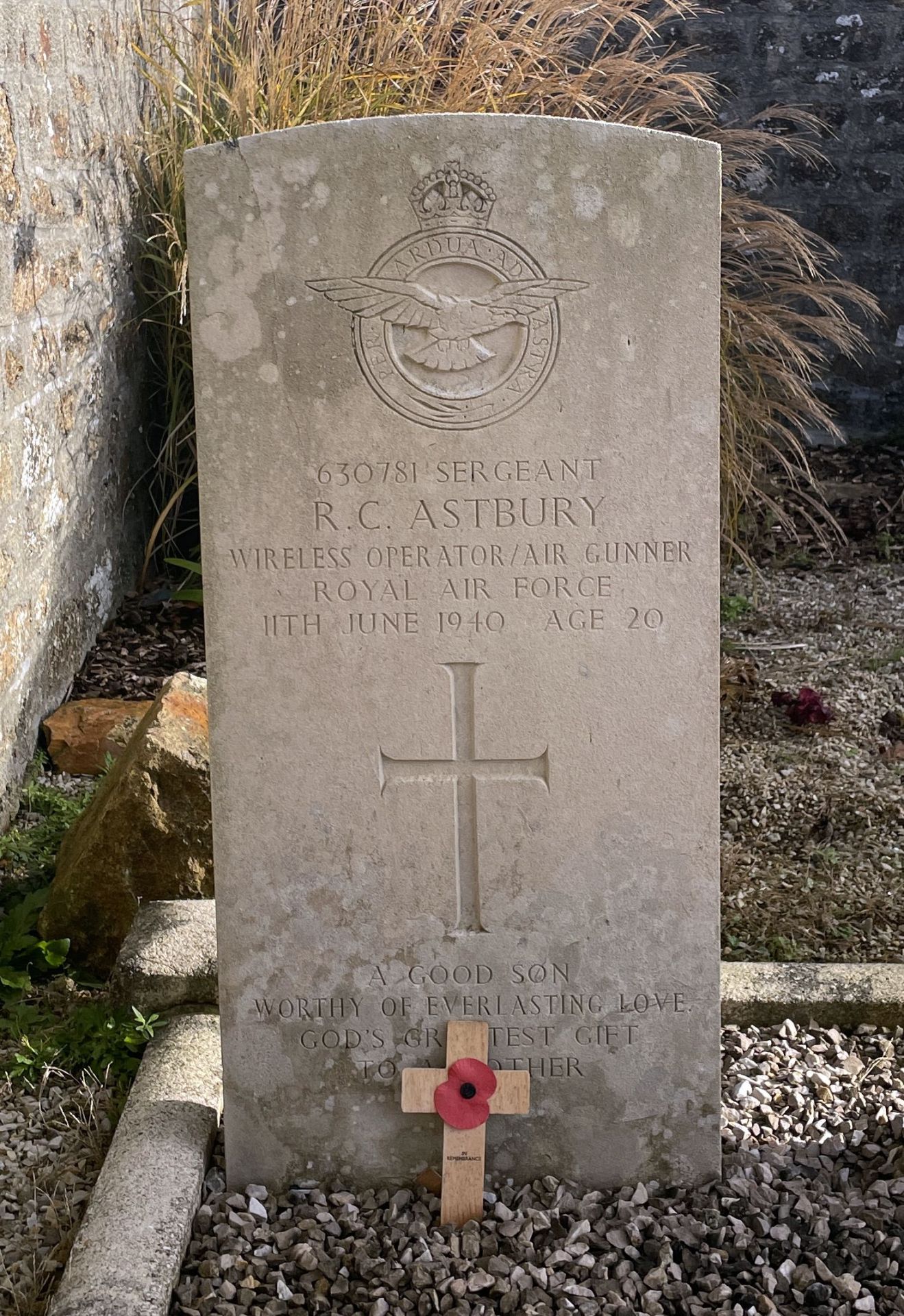
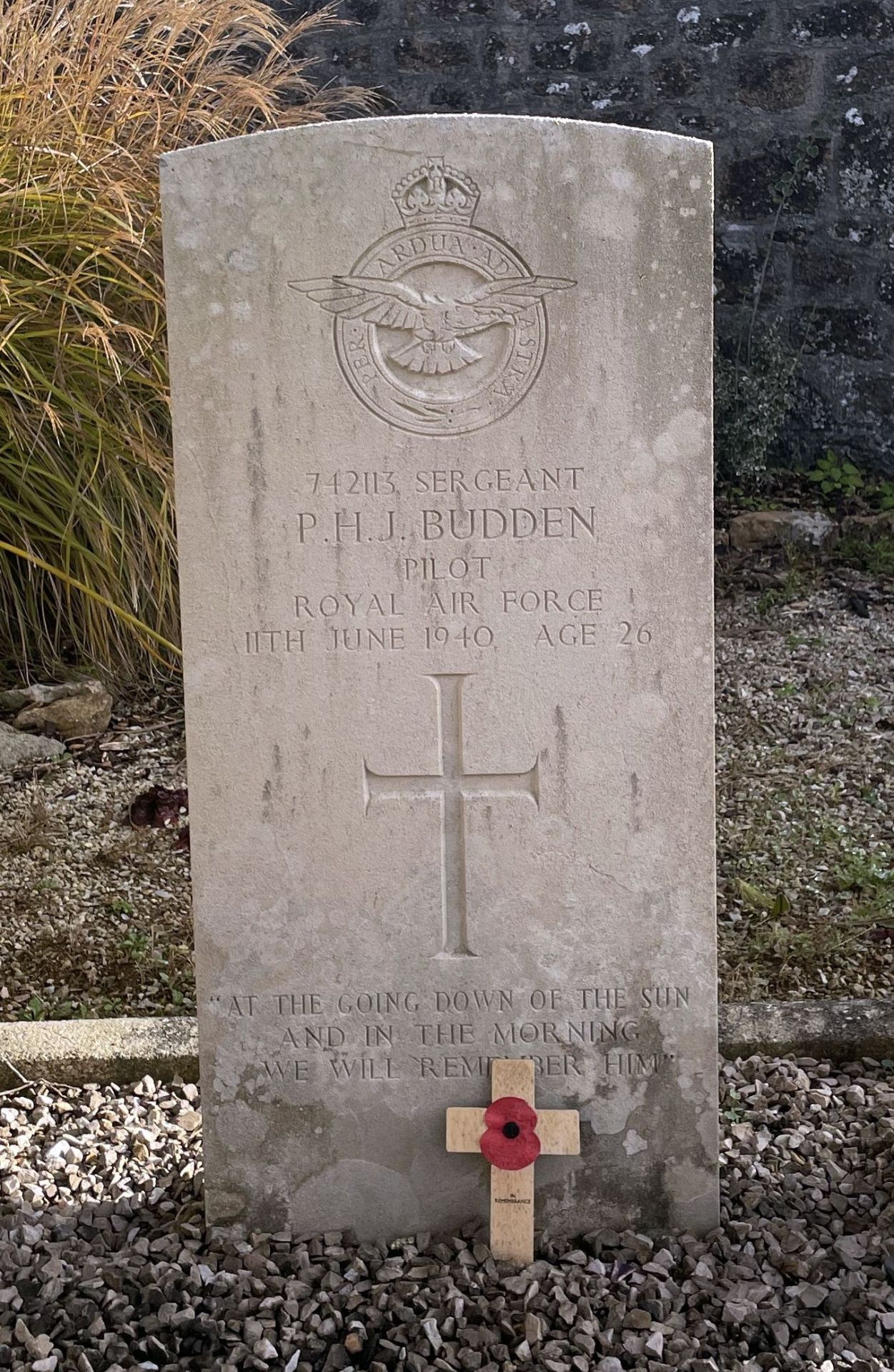
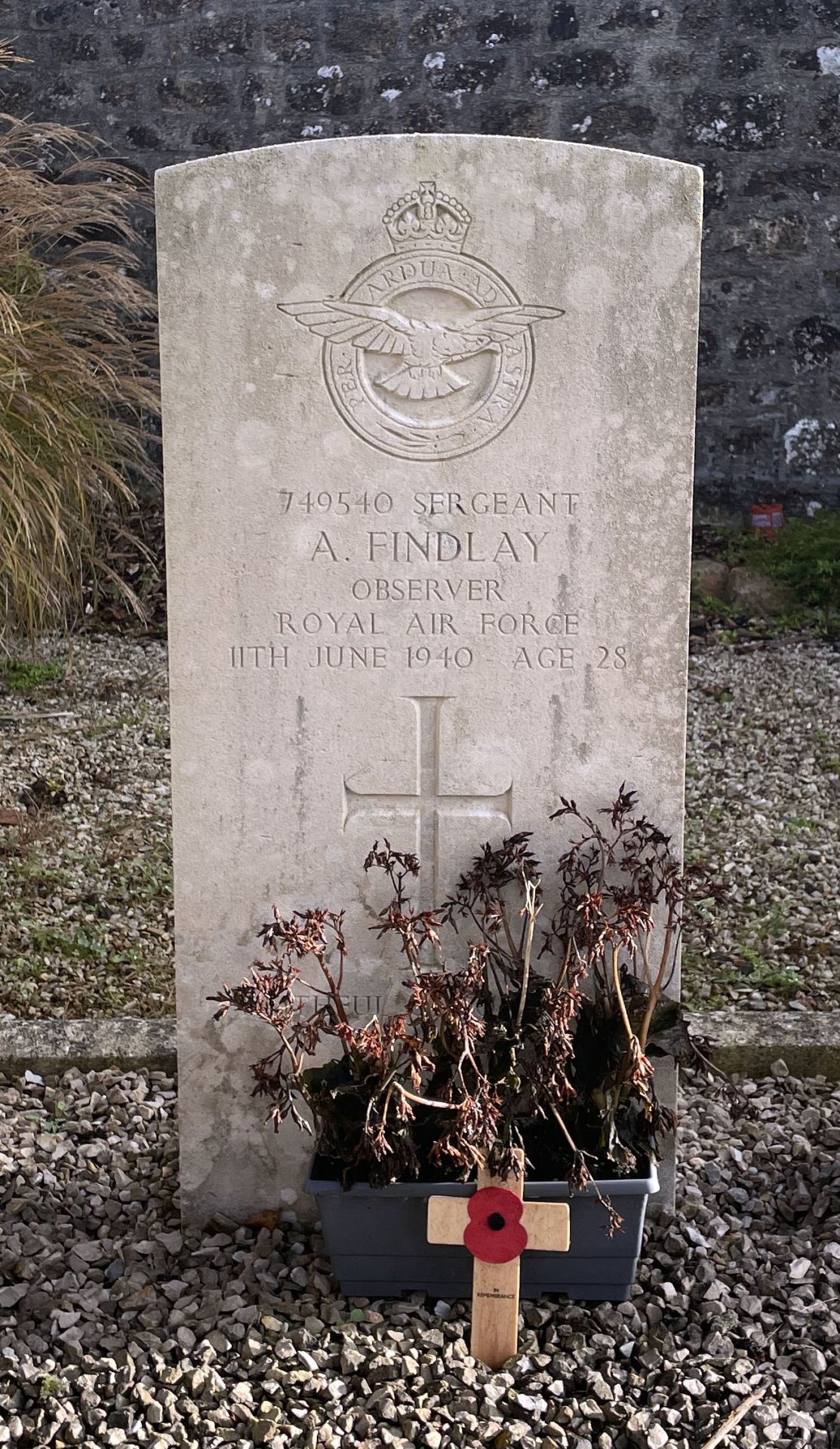
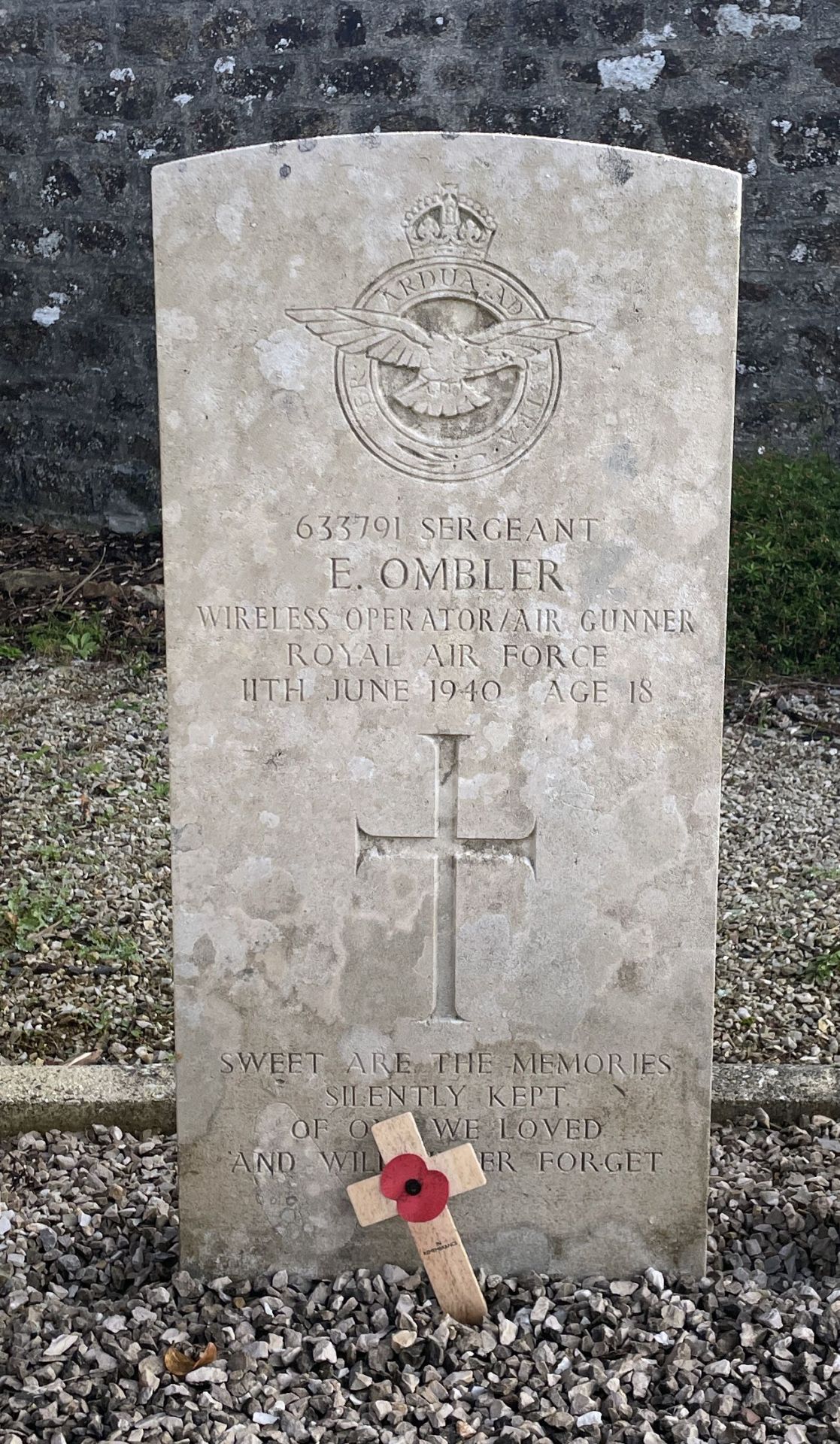
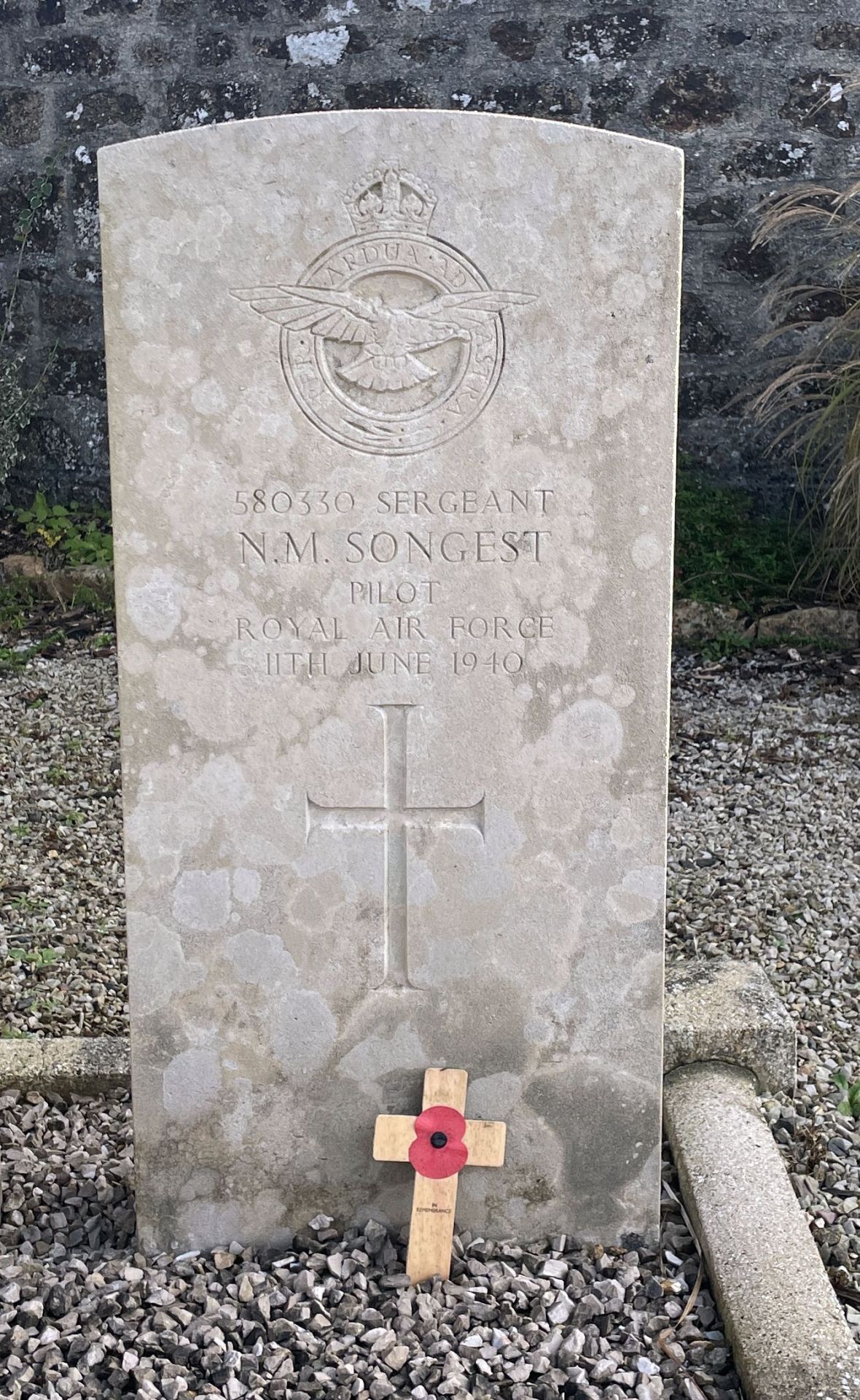
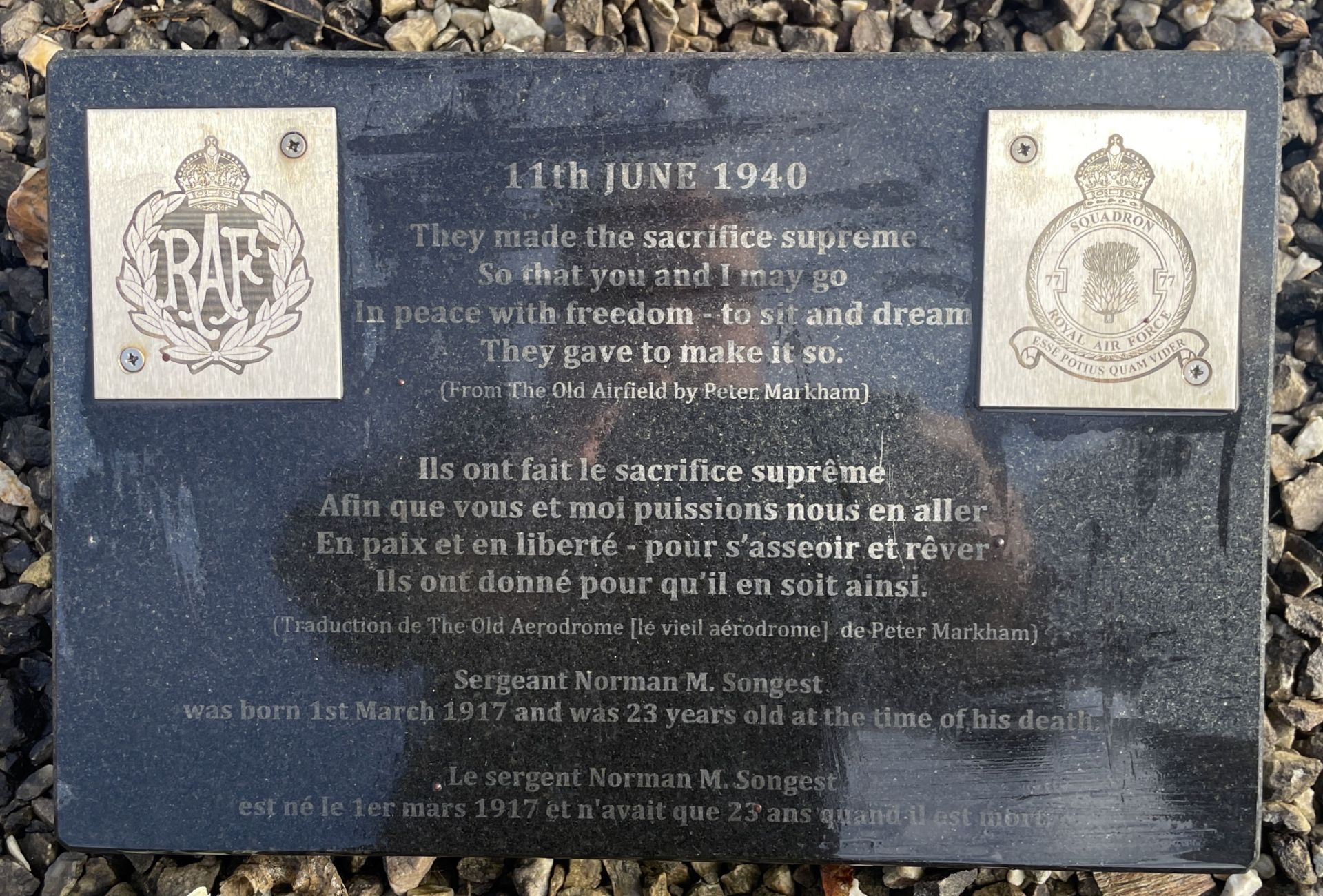
The plaque in front of the graves.
Photo ABSA 39-45 - Benoit Paquet
APPENDICES
♦ Operational Book Record of No. 77 Sqn for 11 June, 1940
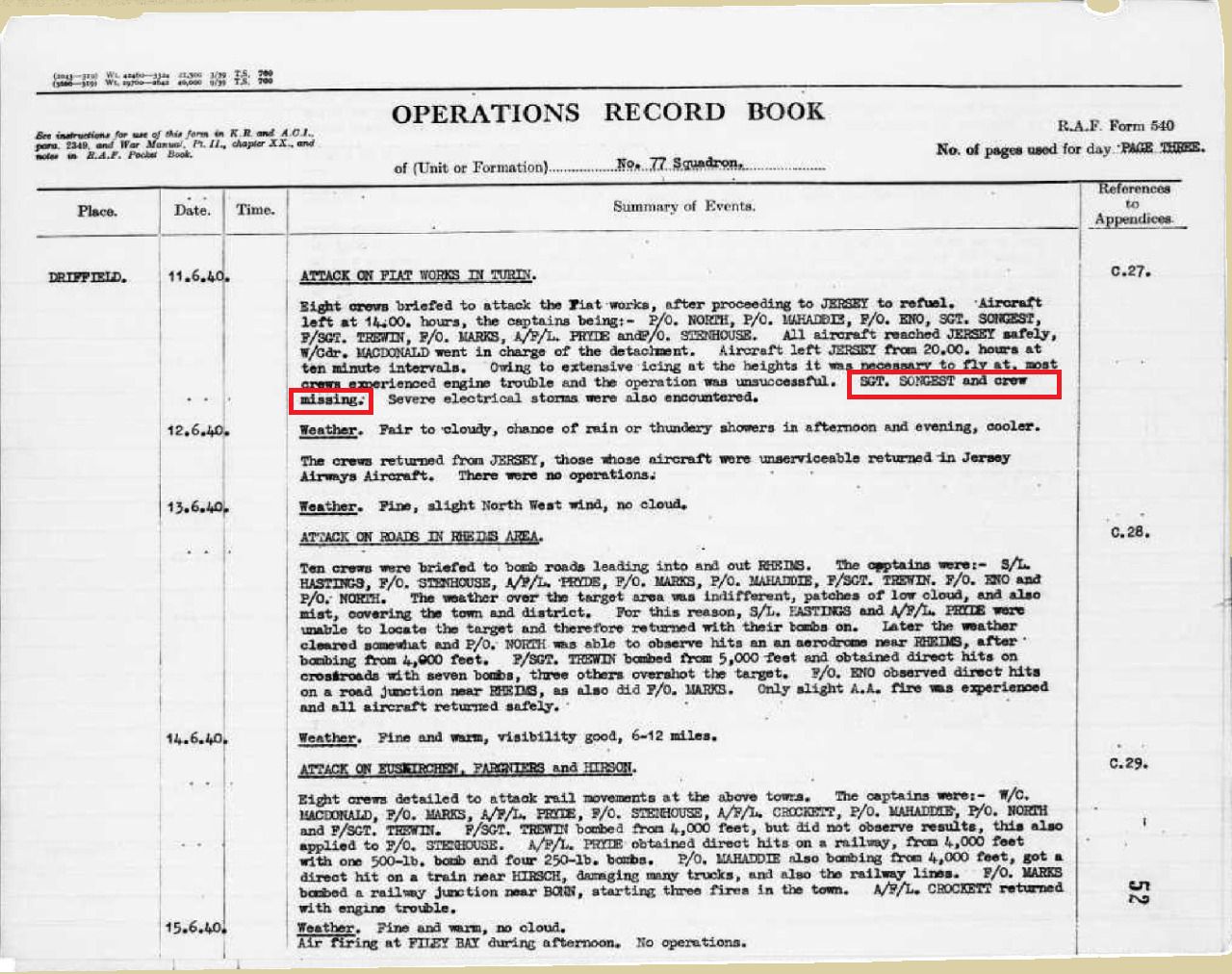
The Operational Record Book of No. 77 Squadron for June 1940 records that on 11 June, the crew of Sergeant SONGEST were reported missing.
Source : The National Archives
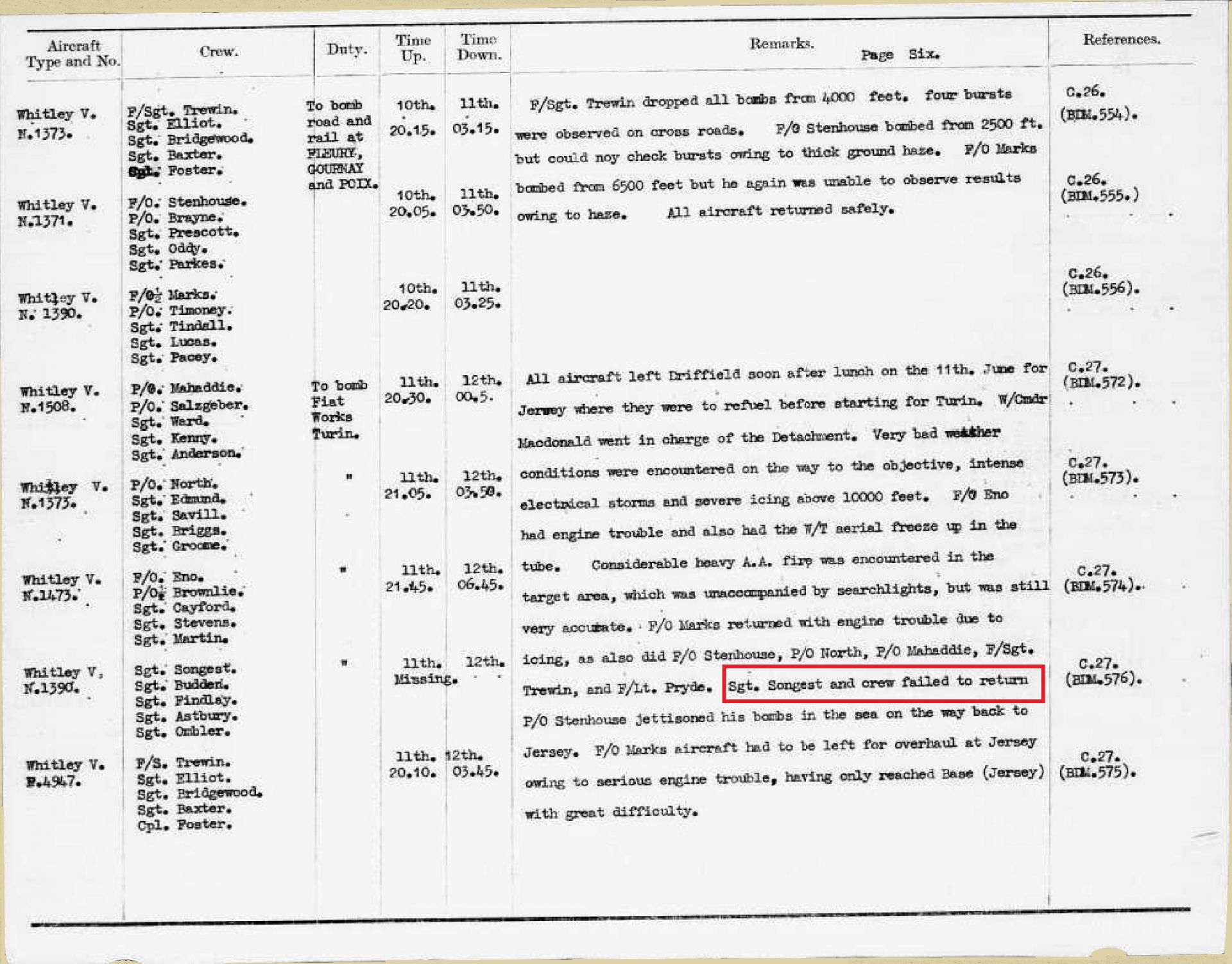
In this other page of No. 77 Squadron's ORB, we find the list of the eight crews that participated in the mission.
Note the mistake concerning SONGEST's aircraft : the serial number is listed as N1390 instead of N1362.
N1390 was assigned to the crew of F/O. Marks.
Source : The National Archives
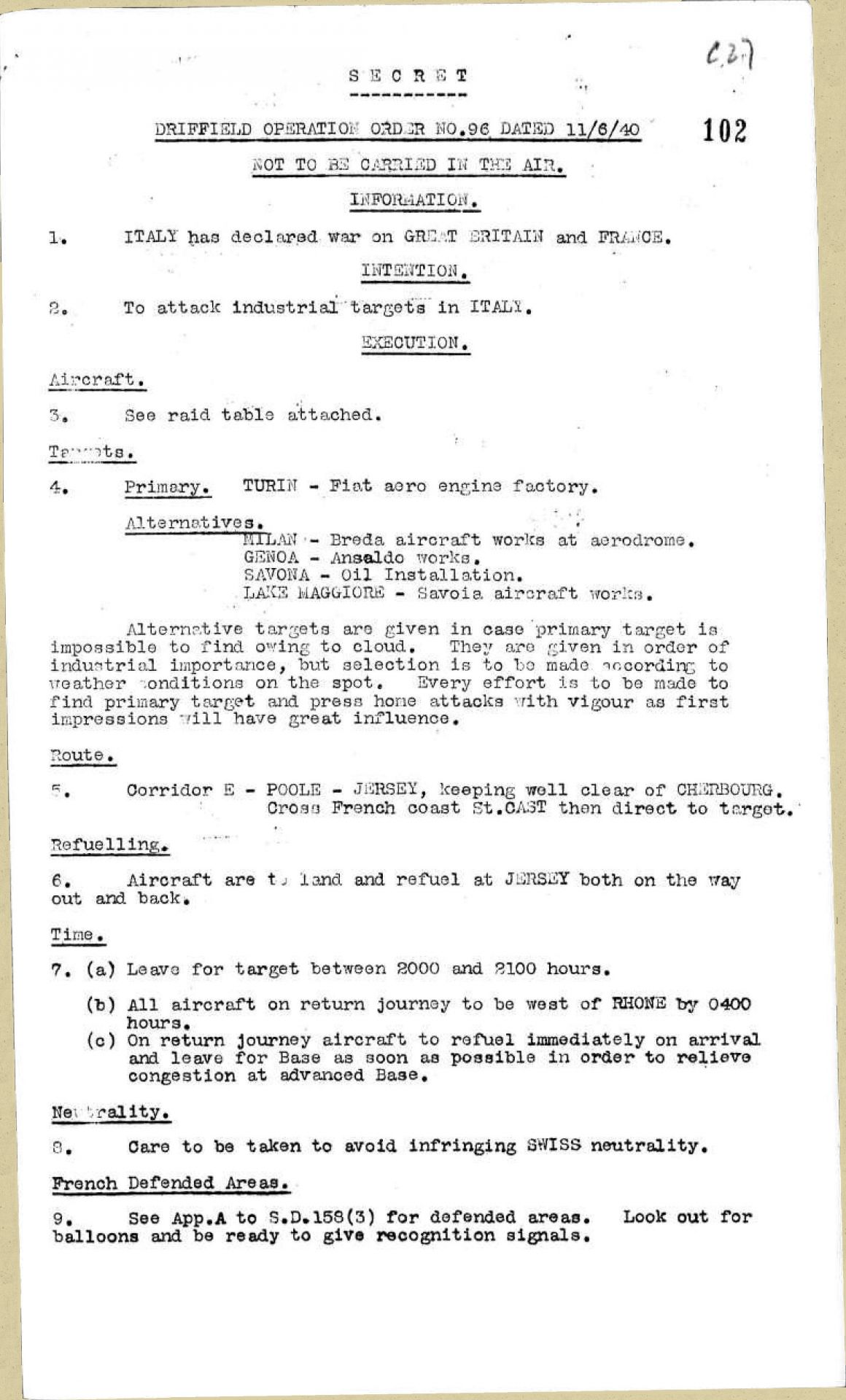
In this document, we read that Turin was the primary target, but that secondary targets had been defined :
Milan, Genoa, Savona, and Lake Maggiore. The aurcrafts' first flight was towards Driffield, Poole, and Jersey.
Then the aircrafts were to take off again between 8:00 pm and 9:00 pm [in fact, they took off between 8:05 pm and 9:45 pm, according
to the previous document] and were to cross the French coast at Saint-Cast [presumably Saint-Cast le Guildo, in the "Côtes du Nord" department].
For the return flight, the aircrafts were instructed to fly west of the Rhône River before 4:00 am and quickly refuel in Jersey to relieve
congestion at the base.
Source : The National Archives
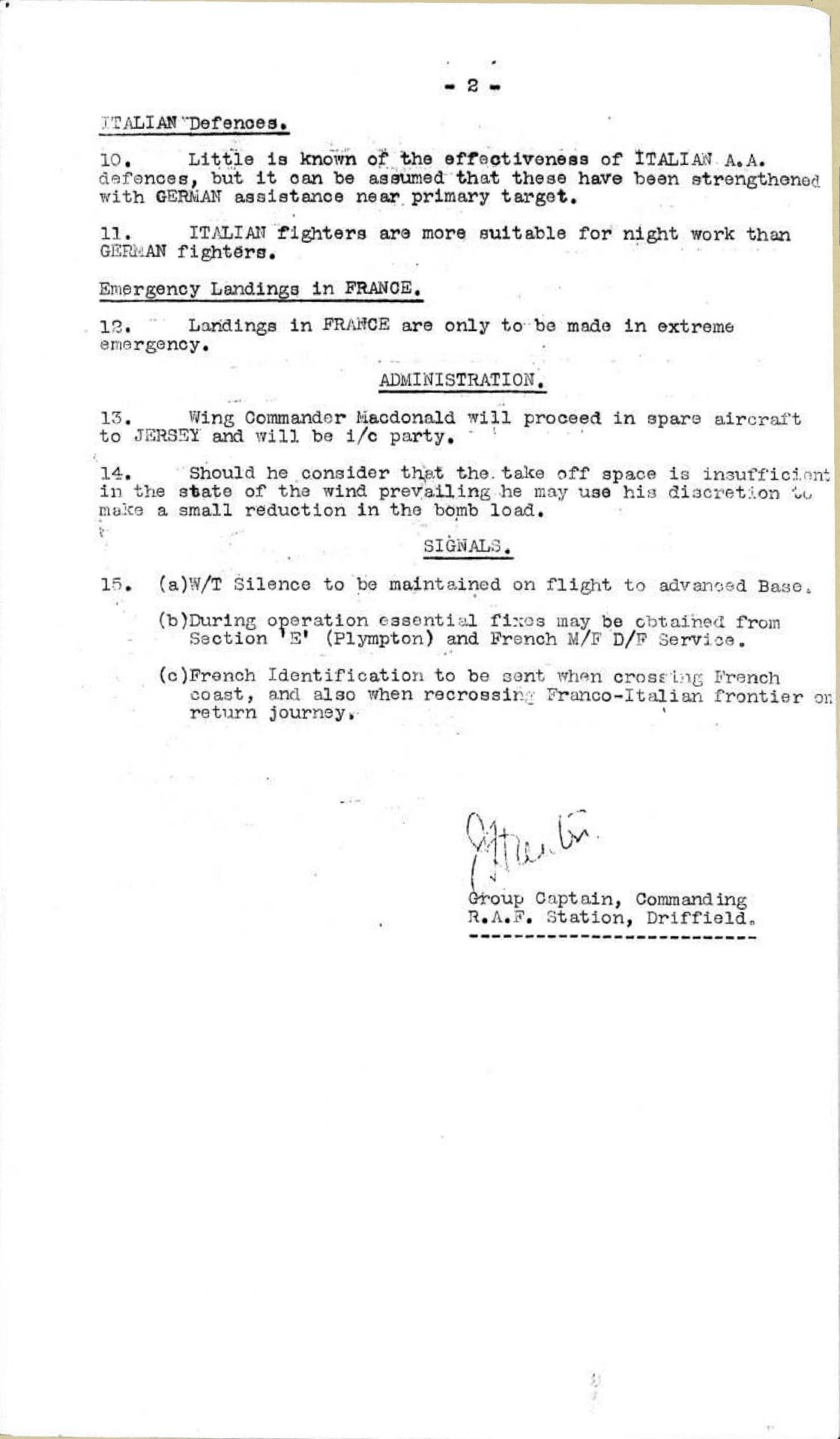
In this second document, it was stated that German flak in Italy could be more intense than that of the Italians.
On the other hand, Italian fighters seemed more dangerous for night "work".
Landings in France were reserved for emergency landings. Radio silence was requested for the flight to Jersey.
Source : The National Archives
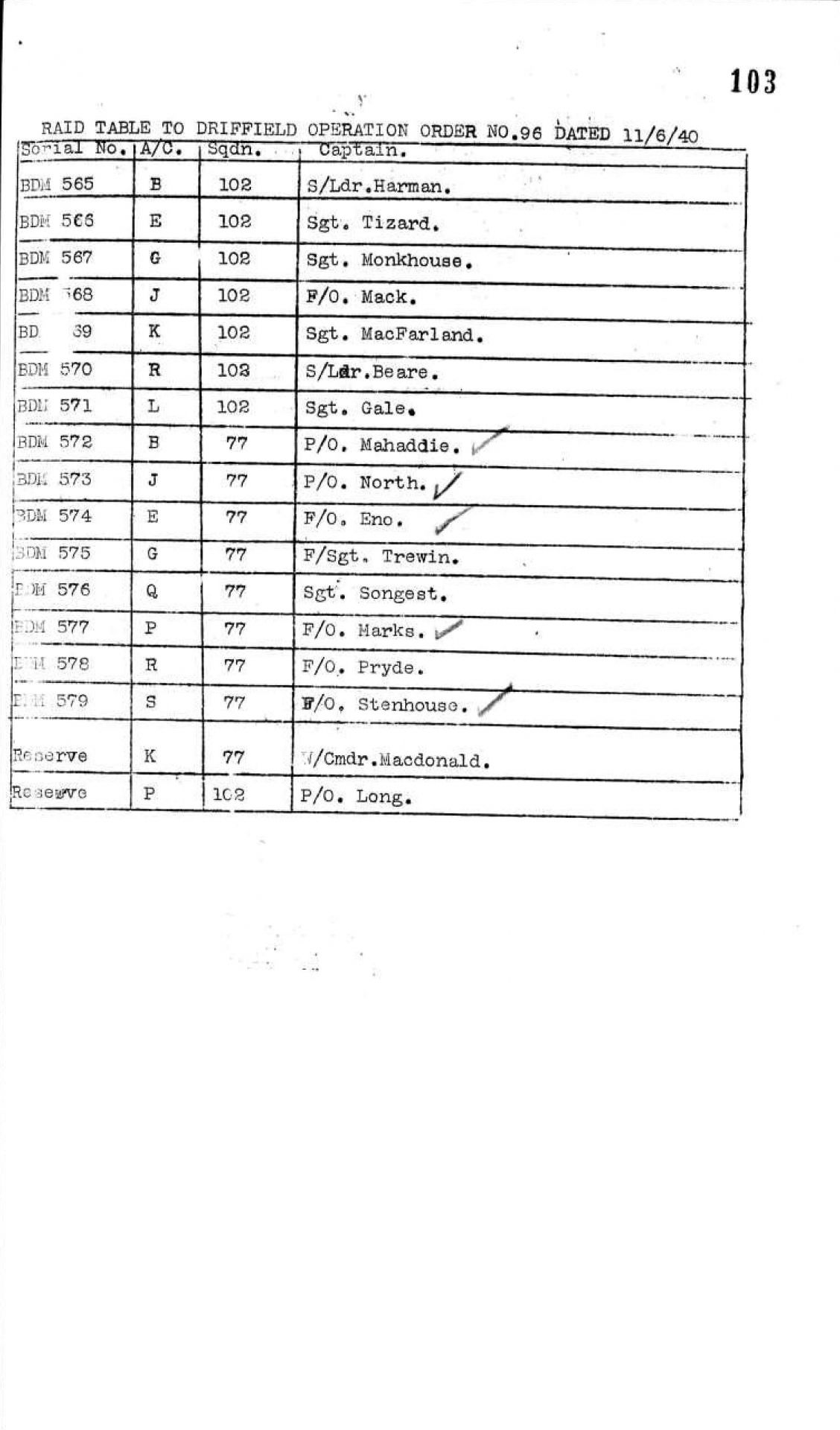
List of aircrafts designated for the June 11, 1940, mission, including the eight aircrafts of No. 77 Sqn.
SONGEST's aircraft had the letter Q (code KN-Q).
Source : The National Archives
♦ Document of the National Archives
(source : Ombler family)
This document reveals information about what happened to the bodies of the five airmen :
CASE No. 3
132. Whitley N1362 was one of the last British aircraft based in the Channel Islands before they were relinquished to the Germans. It left its base in Jersey on the night of 11th/12th June, 1940, for Turin, whith a crew of five sergeants, the pilot being Sergeant N.M. Songest, and one of his crew Sergeant P.H.J. Budden. The target, in northern Italy, involved a long journey over France.
133. Shortly after the disappearance of the aircraft a garbled report was received from France through the War Office which was interpreted to the effect that Sergeant Songest and two other sergeants had been brought in dead to No. 9 General Hospital. There was no mention of a burial. By the time the report had been received No. 9 General Hospital had been evacuated. It was ascertained from the War Office that the hospital had been temporarily situated near Le Mans (Sarthe), but the War Office was unable to be more precise, as all the hospitals’s records were lost in the evacuation. Special but fruitless enquiries were made during the war through the International Red Cross to ascertain the burial place of the three sergeants.
134. Six years later No. 1 Unit was sweeping the area around Le Mans and found that in the cemetery at le Grand Luce, a village about 15 miles to the south, there was a British Military Annexe. It contained a number of known and unknown graves, of soldiers and airmen who had died in France up to June, 1940, and in one of them were found the bodies of two airmen and three soldiers. One of the airmen was unidentifiable ; the other wore a gold signet ring marked N.M.S. – the initial of the pilot of the Whitley, Sergeant Songest. The ring was sent to the Casualty Branch who showed it to Sergeant Songest’s father. He recognized it as his son’s. The other airman in the grave was undoubtedly one of the other four members of the crew. There was no trace of the third sergeant mentioned in the corrupt message from No. 9 General Hospital.
135. At the same time the Missing Research and Enquiry Unit was investigating a crash 50 miles to the north-east, at the village of Orgères-la-Roche (Mayenne). It was ascertained that on the night of 11th/12th June, 1940, a British aircraft had crashed and exploded in the commune. At that time, the department of Mayenne had not yet been occupied by the Germans. Some French officers inspected the wreckageand a few days later a British Red Cross party arrived and were said to have taken some of the bodies away in a truck in an unknown destination. Later, when the Germans arrived, the remaining bodies were placed in a large wooden coffin and buried in the communal cemetery at Lignières-la-Doucelle, about three miles south of Orgères-la-Roche.
136. The grave, when visited by the Search Officers, was found to bear the inscription « Here lie four English Flyers ». Exhumation did not reveal the number of the occupants as they had been disintegrated in the crash but it did yield one important clue, a Ronson lighter in reasonably good conditions, engraved P.B. Dec. 2nd, 1939. Relics such as rings, cigarettes cases and lighters with initials are a considerable help in Missing Research but they are more helpful if these have three or four initials. Two-initial inscriptions such as « P.B » just mentioned do not usually narrow the field of investigation conclusively enough. Dates inscribed on relics are a useful indication, as they almost invariably are birthdays and the objects are often twenty-first birthday presents.
137. Investigation in the Casualty Branch made it probable, by elimination, that the crash at Orgères-la-Roche was that of Whitley N.1362, but itw as difficult to reconcile it with the discovery 50 miles away of the body of the pilot. However, they pursued the clue of the Ronson lughter. The only member of the crew to whom the initials « P.B. » could refer was Sergeant P.H.J. Budden. The date « Dec. 2nd. 1939 » was then tested and itw as found that Sergeant Budden was born on 4th (not 2nd) December, 1913 ; therefore the lighter, if Sergeant Budden’s, was not a birthday present.
138. A letter to the next of kin, however solved the mystery. Sergeant Budden was married on 2nd December, 1939, and the lighter was a present from his bride. The lighter, which had been forwarded with the investigating officer’s report, was sent to Mrs. Budden and she recognised it.
139. Conclusive proof now existed that two of the crew were buried at Le Grand Luce and the remainder at Lignères-la-Doucelle. Two old errors were brought to light ; two, not three, Royal Air Force sergeants had been brought in to No. 9 General Hospital and three not four sergeants were in the grave at Lignières-la-Doucelle.
140. The probable explanation of the separation of the five members of the crew is that the British Red Cross party referred to above collected such remains as they could find and took them to the hospital, which at that time was mobile and fugitive. When the Germans arrived they found further remains at the scene of the crash and buried them locally.
141. The work put into this intractable problem, both in the field and in London, called forth cordial letters of approbation from the next of kin.


♦ Other document, dated 17th June , 1946, of the National Archives
(source : Ombler family)
This document reveals information about the circumstances of the crash and the days that followed :
RESULT OF INVESTIGATION AND FINDINGS :
At approximately 2130 hrs. on the night of 11/6/1940, a British aircraft crashed in flames on the farm of “La Boulardière” in the Commune of ORGERES LA ROCHE. The aircraft was seen to explode in mid-air, as there was neither German ack-ack, nor fighter aircraft in the vicinity, it is presumed that the cause of the crash was accidental.
2. The farmer on whose land the crash occurred told the following story :
“At the time of the crash, the département of MAYENNE was not as yet under German occupation, and it was in fact some fifteen days later that the German occupation forces arrived in that part of France. On the morning of the 12th June, 1940, a party of French officers arrived to investigate the crash. These French officers informed the farmer that they had come from RENNES, and mentioned also that it was the aircraft’s first flight since being overhauled and repaired." From these remarks it would seem that the aircraft had been based at the British aerodrome at RENNES.”
3. The French officer in charge of the investigation informed M. NORMAN, the Mayor of Orgeres, that the bomb load was still unexploded, and that it would be dangerous for any person to approach the wreck, and that the British Red Cross would be notified as to the bodies of the aviators lying in the field adjacent to the aircraft. As a result of this, the Mayor gave orders to the civilian population that neither the wreck nor the bodies were to be approached.
4. Some five days later, a British Red Cross party arrived. The subsequent action of this party are vague and not easily understood, as they worked alone without the aid of any of the French population. They were seen to examine the bodies, and were thought to have loaded three bodies into a truck, and left another four lying in the fields [In fact, there were only 5 airmen on the plane].
5. Still the French did not approach the wreck, and it was not until the German occupation forces arrived, about the 25th June, that a thorough investigation was carried out. The Germans removed the remaining traces of the wreckage and found also four badly burnt and mutilated bodies of British airmen. These four bodies were placed in large wooden coffin and interred in the cemetery of Lignères, five kilometers south of Orgères.
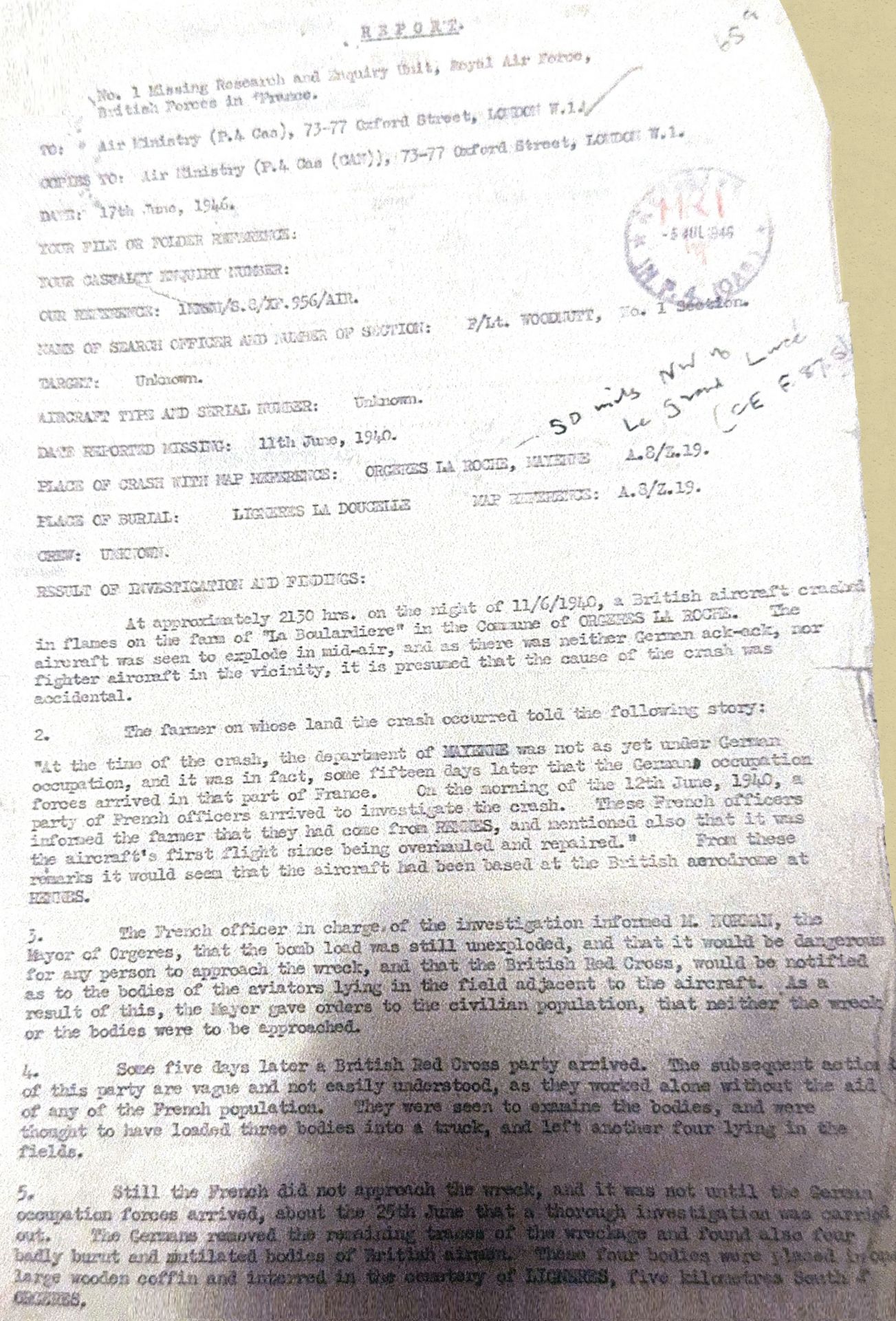

Ajouter un commentaire